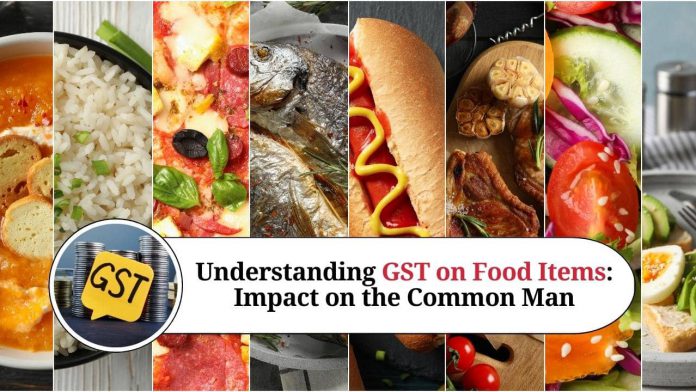The Goods and Services Tax (GST) is a unified tax system that replaced many indirect taxes in India. It is a comprehensive tax that is levied on the supply of goods and services in the country. GST has been implemented in India since July 1, 2017. The GST on food items is a topic of interest to many people. In this blog, we will discuss the impact of GST on food items.
GST on Basic Food Items
Basic food items such as rice, wheat, pulses, fruits, and vegetables are exempt from GST. This means that these items are not subject to GST and are not taxed. The reason for exempting these items from GST is to ensure that essential food items are affordable and accessible to all sections of society.
GST on Processed and Packaged Food Items
Processed and packaged food items such as biscuits, namkeens, sweets, and snacks are subject to GST. The GST rate on these items is 5%. This means that if you buy a packet of biscuits worth Rs. 100, you will have to pay Rs. 5 as GST.
GST on Restaurant Food Items
Food served in restaurants, hotels, and eateries is subject to GST. The GST rate on restaurant food items is 5% for non-AC restaurants and 18% for AC restaurants. The reason for the difference in the GST rate is that AC restaurants provide additional services such as air conditioning, and hence, are subject to a higher rate of GST.
GST on Food Delivery Services
Food delivery services such as Swiggy and Zomato are also subject to GST. The GST rate on these services is 18%. This means that if you order food worth Rs. 500, you will have to pay Rs. 90 as GST.
Impact of GST on Food Industry
The implementation of GST has had a significant impact on the food industry in India. While the GST on basic food items has ensured that essential food items are affordable and accessible to all sections of society, it has also affected the pricing of processed and packaged food items, restaurant food, and food delivery services.
One of the positive impacts of GST on the food industry is that it has simplified the tax system. The GST has replaced several indirect taxes such as VAT, Service Tax, and Excise Duty, making the tax system more straightforward and easier to understand.
Another positive impact of GST is that it has helped reduce the cascading effect of taxes. The previous tax system was characterized by multiple taxes at different stages of the supply chain, leading to a higher tax burden. However, with the introduction of GST, the cascading effect of taxes has been reduced, leading to a more efficient and streamlined tax system.
Read Other Useful Blogs:
On the other hand, the introduction of GST on processed and packaged food items has led to an increase in the cost of these products. The GST rate of 5% on these items has led to an increase in the cost of production, which has been passed on to the consumers.
Similarly, the GST rate of 18% on restaurant food and food delivery services has also led to an increase in the cost of these services. This has affected the affordability of restaurant food and food delivery services, especially for people with lower income.
GST on Food Items and the Common Man
The GST on food items has a significant impact on the common man as it affects the affordability of food. Basic food items are exempt from GST, which is a positive move for the common man as it ensures that essential food items are affordable and accessible.
However, the GST on processed and packaged food items, restaurant food, and food delivery services has increased the cost of these products and services, affecting the affordability of food for the common man.
In addition, the GST on restaurant food and food delivery services has affected the hospitality industry, especially small and medium-sized restaurants. With a GST rate of 18%, it has become more expensive to run a restaurant, and this has affected the profitability of small and medium-sized restaurants.
On the other hand, the GST on food delivery services has had a positive impact on the industry. With the implementation of GST, food delivery services have become more organized and efficient. The GST has ensured that food delivery services operate within a standardized tax system, which has made it easier for them to comply with tax laws.
Conclusion
GST has had a significant impact on the food industry in India. The GST on basic food items has ensured that essential food items are affordable and accessible to all sections of society.
However, processed and packaged food items, restaurant food items, and food delivery services are subject to GST, which has increased the cost of these items. It is important to note that GST is a comprehensive tax that is levied on the supply of goods and services, and it is essential for the growth and development of the Indian economy.
It has simplified the tax system, reduced the cascading effect of taxes, and increased the efficiency of the tax system. However, there is a need to strike a balance between the benefits of GST and its impact on the affordability of essential food items and food services.
This can be achieved by ensuring that the GST rates on processed and packaged food items, restaurant food, and food delivery services are reasonable and do not place an undue burden on the common man.
Additionally, there is a need to provide support to small and medium-sized restaurants to help them cope with the impact of GST on their businesses.
Frequently Asked Questions (FAQs)
Q.1) What is GST on food items?
GST or Goods and Services Tax is a tax imposed on the supply of goods and services in India. The GST on food items refers to the tax rate applicable on food products, which may vary based on the category of food item.
Q.2) What is the GST rate on basic food items?
Basic food items such as milk, eggs, fresh vegetables and fruits, unbranded atta, and unbranded maida, among others, are exempt from GST.
Q.3) What is the GST rate on processed and packaged food items?
The GST rate on processed and packaged food items is 5%. However, some processed and packaged food items such as chocolate and cocoa products, aerated water, and sugar confectionery attract a GST rate of 18%.
Q.4) What is the GST rate on restaurant food?
The GST rate on restaurant food is 5%. However, restaurants with a turnover of more than Rs. 1.5 crore have to pay a GST rate of 18%.
Q.5) What is the GST rate on food delivery services?
The GST rate on food delivery services is 18%. This rate is applicable to all food delivery services irrespective of their turnover.
Q.6) What is the impact of GST on the food industry?
The implementation of GST has had a significant impact on the food industry in India. While the GST on basic food items has ensured that essential food items are affordable and accessible to all sections of society, it has also affected the pricing of processed and packaged food items, restaurant food, and food delivery services.
Q.7) Is GST on food items the same across all states in India?
Yes, the GST on food items is the same across all states in India. However, some states may levy additional taxes such as the entry tax or octroi on food items.
Q.8) Can I claim GST paid on food items as input tax credit?
Yes, if you are a registered dealer, you can claim the GST paid on food items as input tax credit. However, the food items should have been purchased for business purposes.
Q.9) Is GST applicable on food items sold through e-commerce platforms?
Yes, GST is applicable on food items sold through e-commerce platforms. The GST rate will depend on the category of food item.
Q.10) Can I get a refund of GST paid on food items?
Yes, you can claim a refund of GST paid on food items under certain circumstances such as export of goods or if the GST paid is more than the actual liability.




















